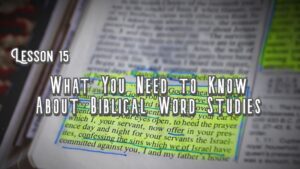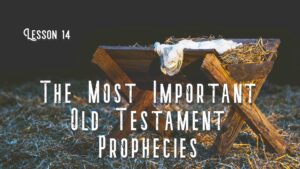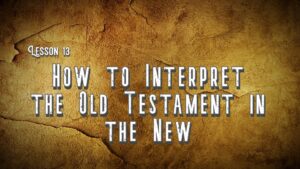If you didn’t skip any lessons to this point in the series you have either learned a lot or are looking for something more intense at this point. If “learned a lot” is rubber and “looking for something more intense” is road, then Lesson 9 is here to put rubber to the road. Open your Bible and your mind as we unfold the context of Acts as a book, and specifically Acts 2:38-39, applying the seven context questions from Lesson 8.
The Theological Question
How does this Bible passage or Bible book develop the greater story of the Bible? Lesson 8 noted two themes that span the unified Bible: the kingdom of God and the redemption fulfilled in Jesus Christ. When considering the theological context of Acts 2:38-39, we must determine which of these two themes are being emphasized in Acts as a whole. While both themes receive attention in Acts, notice the emphasis on the kingdom of God. First, note that the Gospel of Luke and the Book of Acts are actually a unified narrative intended to be read together. Both books are addressed to Theophilus (Luke 1:3 & Acts 1:1), Acts picks up directly where the Gospel of Luke leaves off (Luke 24:50-53 & Acts 1:4), and both books heavily emphasize the kingdom of God and the spiritual restoration of Israel (redemption) at both their beginnings and endings (Luke 1:32-33; 24:21 & Acts 1:6; 28:20), not to mention the heavy stress these two themes receive throughout the bodies of both works. Second, the book of Acts starts with a recap of the Gospel of Luke. The climactic ending to this recap is as follows, “(Jesus) being seen by them (the apostles) during forty days and speaking of the things pertaining to the kingdom of God,” (Acts 1:3). This highlights the theme of Acts from the very onset, the kingdom of God. Keep this overarching biblical theme on the bridge of your nose like a pair of reading lenses as you attempt to discover the meaning of Acts 2:38-39 in context.
The Literary Question
What type of literature am I reading? The simple answer is brief: primarily the book of Acts is historical narrative. This means, as opposed to apocalyptic literature (i.e. Revelation), Luke is written primarily using literal language. The “language(s)” of Acts 2:6 are actual, studied, and easily understood human languages which each person comprehended according to their native language. The audience of Acts 2:36 literally “crucified” the Christ as Peter accuses them. The “remission of sins” in Acts 2:8 is literal forgiveness of sins. However, it must be noted, there are many quotations and allusions within Acts (particularly Chapter 2) that refer to Old Testament prophecies written in figurative language (i.e. Acts 2:34-35).
The Dispensational Question
What dispensation or law governed God’s people when this Bible book was written? The book of Acts and the command of Acts 2:38-39 is written under the new Christian dispensation or new covenant dispensation as opposed to the old Mosaic dispensation or old covenant. In Luke 23:45, the veil of the most holy place in the temple is torn upon Jesus giving up His last breath. This signified that neither the temple nor the holy place were holy anymore. There is a new covenant and law that takes the place of the old Mosaic covenant starting with Jesus’ death (Hebrews 9). Therefore, men no longer have to worry about disfiguring the edges of their beard (Lev. 19:27), but they do have to observe the new commandments given to those that would seek to be Christians and receive forgiveness of sins in Acts 2:38-39.
The Situational Question
During what situation, culture, and time was this Bible book written? Most biblical scholars agree the book of Acts was written roughly around 60 A.D. The Roman Empire ruled the nation of Israel at this time, and there was no sign of deliverance from Rome. When Jesus came claiming to be the coming Messiah, the people misinterpreted this to mean He would physically deliver them from Rome (John 6:15). Peter preaches his sermon in Acts 2 amidst this time of Jewish tragedy, heightened by the fact that the claimed Messiah was just killed by His own people (Acts 2:36).
The Audience Question
Who is the audience of this Bible book or verse? The audience is plainly identified as a man named Theophilus (Acts 1:1). Although a Greek name, this was actually a common name among Jews and Gentiles in the 1st century. I lean toward the persuasion that Theophilus must have been a Jewish or Gentile convert. Otherwise, Luke is expecting an unconverted Gentile to be extremely familiar with the Old Testament, as the Gospel of Luke and the book of Acts are deeply entrenched in a rich use of the Old Testament.
The Motivation Question
What motivated the author of this Bible book to write the things he did? While there is room for conjecture in answering this question, there are two items that point to a certain motivation for Luke to write the book containing Acts 2:38-39. First, Luke wants to declare the coming of the kingdom of God over a redeemed, spiritual Israel, while at the same time highlighting the fact that physical Israel, for whom this promise was meant, has largely rejected God’s kingdom and His special plan to redeem them (Acts 28:20). Second, Luke writes the letter as an eyewitness account to the certainty of the events pertaining to and following the mission of Jesus Christ. This second motivation is clearly outlined in Luke 1:1-4 and Acts 1:1-3.
The Immediate Context Question
What surrounds the Bible book or verse I am reading? Pertaining to the specific verses in Acts 2:38-39, ponder how all six questions answered so far shed light on the meaning of these two verses. We should expect Peter to proclaim to the Jews in Jerusalem about the kingdom of God. He does just that. Acts 2:17-21 is a quotation from Joel 2:28-32. Joel 2 is a prophecy which anticipates the restoration of Israel. Next, in Acts 2:25-28, Peter quotes from Psalm 16:8-11, a promise that the Messiah would resurrect, never to die again. Lastly, in Acts 2:34-35, Peter quotes Psalm 110:1 which is a prophecy picturing Messiah ruling as the king of heaven and earth. This all leads beautifully into Acts 2:38-39 where Peter gives the conditions for receiving the blessings of salvation and spiritual gifts promised by Joel. According to Peter, the conditions of entrance into the restored Kingdom of God are repentance (just as Jesus commanded in Luke 24:47) and burial in water — reenacting the death, burial, and resurrection to glory of the risen King Jesus (Romans 6:3-5). Such an act results in the washing away of sins (Acts 22:16) or “remission of sins” as Peter puts it.
This lesson was a little more difficult than prior lessons. If Lesson 8 seemed too easy then Lesson 9 shows how Bible study can be a bit more complex when getting in the thick of it. Do not let this lesson discourage you. I did not discover all the contextual angles of Acts 2 overnight. In fact, I heard many sermons on Acts 2 growing up in the church before I started to truly understand its deeper connection to other scriptures through Bible study. Good study habits and fruits of labor take time and patience, so do not lose heart.
Homework Questions
1. True or False:
Although the book of Acts is primarily historical in nature, it contains both figurative and literal language?
2. What event in the gospels signified that the holy place, temple, and the old covenant altogether were no longer in effect?
3. Who wrote the book of Acts, and what world empire ruled during the events recorded in the book?
4. List two factors that motivated Luke to write the book of Acts.
5. Short Answer:
List below the tools and/or questions you initially used when studying Acts 2:38-39 in order to come to your interpretation of Peter’s message.
Helpful Resources
The Acts of the Risen Lord Jesus by Alan J. Thompson
A Popular Survey of the New Testament by Norman Geisler
A Commentary on Acts by J. W. McGarvey



